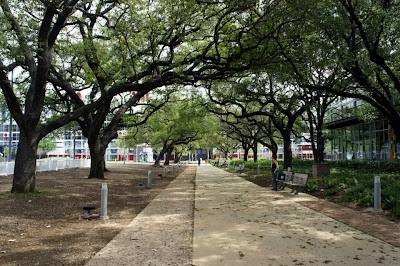Note: This post is being written in April 2013, when I decided to restart my blog by going back to spring break 2012 and filling in the gaps.
Marfa is, without a doubt, one of the coolest and strangest American towns I have ever visited. The town's motto starts to give you an idea of the unlikely foodie and art destination in the high desert of far West Texas: "Tough to get to, tougher to explain."
As Newsday
describes:
It takes so long to get to Marfa, Texas, that you half expect a town crier and trumpeter to herald your arrival. Instead, all there is to stop you from driving straight through this town of 2,000 is a blinking yellow traffic light and the occasional tumbleweed on Highway 90.
But you'll notice right away that this isn't your typical desolate West Texas burg. (For starters, it's named after a character in a Dostoevsky novel). Sixty miles east of the Mexican border, Marfa is the coolest art town in America, with stellar restaurants, a world-class museum, art galleries, an independent bookstore, chic food trailers, funky accommodations, an NPR station and a bar that used to be a funeral home.
When E, S, A, DW and I were planning our road trip, this is one of the videos we watched that convinced us to visit the town:
The nearest commercial airports—Midland and El Paso—are both about three hours from the city. We found an inexpensive one-way flight from Houston to Midland, where we rented a car and beelined it to Rosa's Cafe & Tortilla Factory for some of the best tacos this born-and-bred Texan has ever had in his life before heading out of town on Interstate 20.
Three hours, one left turn, and some pretty neat landscapes later, we were in Marfa, population 1,981.
 |
| The Davis Mountains (from State Highway 17) |
We checked into the Thunderbird Hotel, a once-unremarkable roadside motel-turned-icon of minimalist art, complete with pecan wood furniture, cowhide rugs, Malin + Goetz amenities, and typewriter rentals.
 |
| Thunderbird Hotel pool |
We then rented bikes to explore the town and take advantage of the perfect West Texas spring weather. Below, a few pictures of our bike gang, the Presidio County Courthouse, the Paisano Hotel (where
Giant was filmed), and a few other local attractions:

The most charming part of the town is the town square in front of the county courthouse, which today is occupied by numerous art galleries as well as historic institutions such as the Bank of Marfa.
After dinner (more than a year later, I cannot remember what we had, but given the company I am sure it was delicious) we headed to El Cosmico, a lodging concept that describes itself as "part vintage trailer, safari tent and teepee hotel and campground, part creative lab, greenhouse and amphitheatre—a community space that fosters and agitates artistic and intellectual exchange...a unique communal outpost in the West Texas desert."
 |
| The lobby |
They were having a teepee rave that night, which is pretty much exactly what it sounds like. Unfortunately I was too distracted by the bizarre music, the different images being projected at each of the rave stations, the participating characters, and the overall atmosphere to take more than this one picture in one of the less strange teepees:
 |
| Yes, she is wearing horns |
It seemed like half of the people we met told us they were artists transplanted from Brooklyn, which did make matters a bit clearer.
After filling up on the general hipsterness, we headed out for our last stop of the night, the Museum of Electronic Wonders and Late Night Grilled Cheese Parlour, which had been on our itinerary ever since we saw it in the Etsy movie at the beginning of this post. After one bite of our Gruyère, caramelized onions, roasted brussel sprouts and Dijon mustard grilled cheese sandwich, I had to ask the owner artist/collector Adam Bork (who is, by the way, as quirky as he seems in the video) if he would ever franchise in Houston. He politely replied that he would consider it.
The following morning, we biked over to the Chinati Foundation, a contemporary art museum founded by artist Donald Judd with an emphasis on permanent large-scale exhibits. Our tour guide was artist Mike Bianco, a San Francisco transplant who moved to Marfa to open a studio and store.
A few pictures from the tour (Dan Flavin's
Marfa Project, John Chamberlain various works):
The highlight of the tour was Judd's 100 untitled works in mill aluminum, a fascinating play on form and light with 100 large unique aluminum pieces with the same rectangular outer dimensions. (Photography was not allowed.)
Also found out that some of the buildings were formerly part of a military installation that housed German prisoners of war during World War II. One of the original signs:
 |
"Den Kopf benutzen ist besser als ihn verlieren"
("Better to use the head than to lose it") |
(Generally solid life advice, I would say.)
Our final stop in Marfa was Mike's studio, where I picked up a teacup for Father and a beautiful gray-blue vase that is currently sitting on a bench in my room at home.
 |
| MUD (Marfa Utilitarian Designs) |















